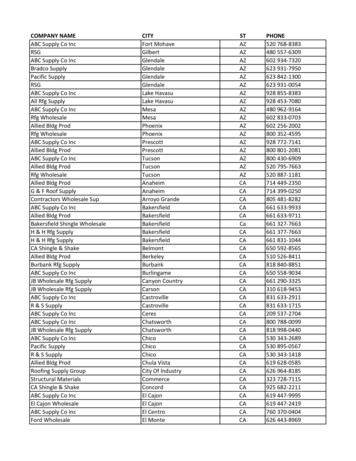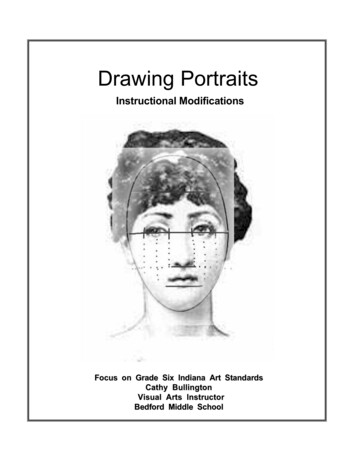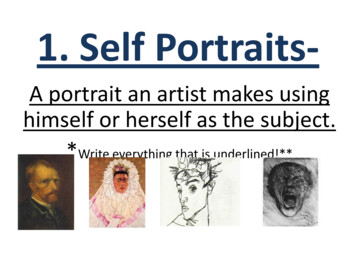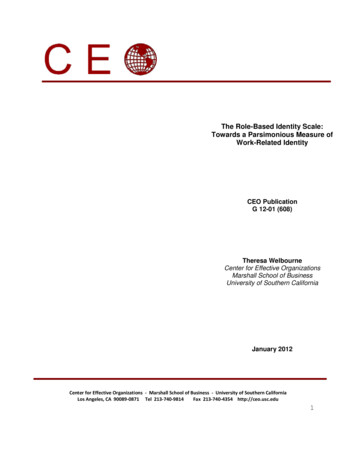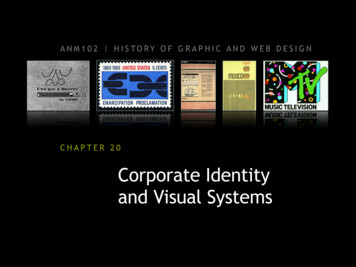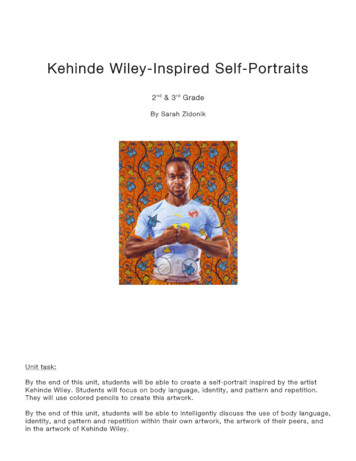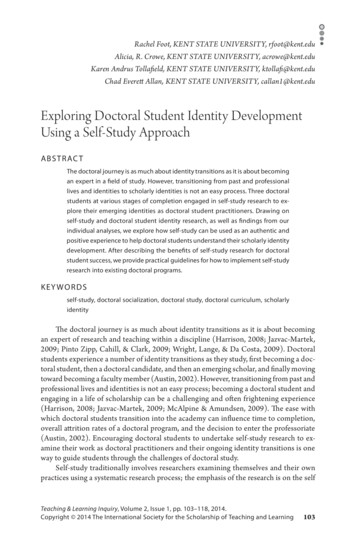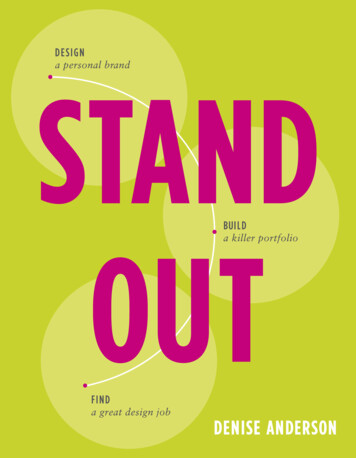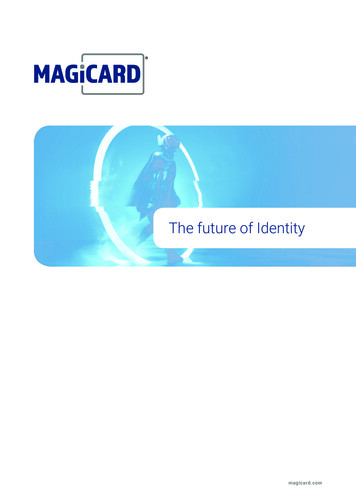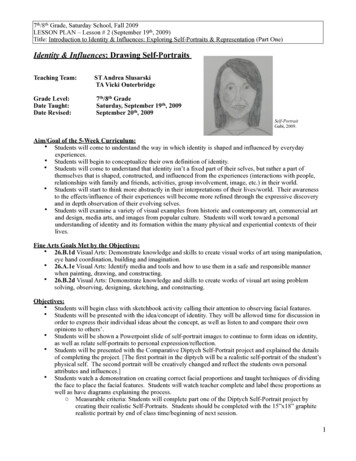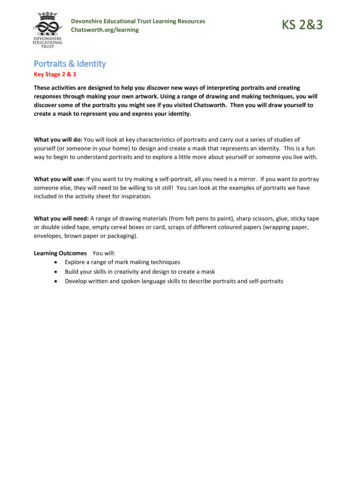
Transcription
Devonshire Educational Trust Learning ResourcesChatsworth.org/learningKS 2&3Portraits & IdentityKey Stage 2 & 3These activities are designed to help you discover new ways of interpreting portraits and creatingresponses through making your own artwork. Using a range of drawing and making techniques, you willdiscover some of the portraits you might see if you visited Chatsworth. Then you will draw yourself tocreate a mask to represent you and express your identity.What you will do: You will look at key characteristics of portraits and carry out a series of studies ofyourself (or someone in your home) to design and create a mask that represents an identity. This is a funway to begin to understand portraits and to explore a little more about yourself or someone you live with.What you will use: If you want to try making a self-portrait, all you need is a mirror. If you want to portraysomeone else, they will need to be willing to sit still! You can look at the examples of portraits we haveincluded in the activity sheet for inspiration.What you will need: A range of drawing materials (from felt pens to paint), sharp scissors, glue, sticky tapeor double sided tape, empty cereal boxes or card, scraps of different coloured papers (wrapping paper,envelopes, brown paper or packaging).Learning Outcomes You will: Explore a range of mark making techniques Build your skills in creativity and design to create a mask Develop written and spoken language skills to describe portraits and self-portraits
Devonshire Educational Trust Learning ResourcesChatsworth.org/learningKS 2&3Portraits & Identity Activity Sheet 1First, let’s understand what a portrait isCan you describe what you think a portrait is in the space below?Portraits are artistic representations of people (in portraits, people are referred to as ‘sitters’, regardlessof whether they are sitting down or standing up!). Portraits can work on different levels: A portrait can capture a physical likeness or quality of a person and/or their personality, social status,job, age and genderAn artist making portraits can present clues about their sitter through pose and facial expression, use ofcolour and space, or objects within the imageSometimes portrait artists flatter their sitters (often described as idealising), or represent them as awell-known historical figure or as a goddess or god (this is known as allegory)Objects are often intended to be symbolic when included within a portrait.A portrait is rarely just a likeness of a personLet’s look at some portraitsUsing the key points provided, explore the two portraits below and try to consider the followingCan you spot what these portraits have in common?Can you connect them to any of the descriptions of portraits in the information provided above?Can you describe their character, status and pose?The Chatsworth Cellarman by WilliamBakerPortrait of Georgiana Spencer,Duchess of Devonshire as Diana byMaria Cosway
Devonshire Educational Trust Learning ResourcesChatsworth.org/learningKS 2&3Portraits & Identity Activity Sheet 2Now it’s time to get creative. Grab your drawing tools, a mirror or your ‘sitter’ and let’s get startedIn the space below, use any drawing tools you like to draw the different features of the faceKeep these drawings quick and fun. Is there a striking feature that makes you or your sitter individual ordifferent? Can you exaggerate this?Next think about the angle or viewpoint you draw from. Draw the side of the nose or just a section of theeyeCan you draw different facial expressions? Smile, frown, or scrunch your nose up.Draw:NoseEyeMouthEarEyebrowsHairWhat colours represent you? Which colours would you like people to link to your personality?Make a colour swatch with felt pens, coloured pencils or paintNow bring these activities together to create a portrait in the form of a mask, with elements that tellsomeone else about you. You can research the artist Picasso to explore more about modern portraits.Picasso became famous for creating very powerful and abstract portraits.Using the drawings & colours you have created, draw or paint the facial features on different papers orpieces of card you have collected. Cut these out and stick them into a large flat piece of card to create amask – make sure it’s bigger than your head.Think about the shapes you use and how you arrangeeach drawing together. What will your pose andexpression be? What clothes, accessories or clues willyou include?Here are some examples to inspire you
Devonshire Educational Trust Learning ResourcesChatsworth.org/learningKS 2&3For parents, guardians or teachersPortraiture informationThe definitions below might help when looking at or discussing the portraits in Activity 1 – and perhaps alsoto work out what kind of portrait children want to make.Abstract: A portrait can be described as ‘abstract’ where it is not instantly recognisable as a physicallikeness of a person. Abstraction usually deals with the realm of ideas, not material reality. Abstractportraiture might substitute an object for a person (Van Gogh’s Chair is a good example of this). Or, it mightbe possible to tell that you are looking at a face – Picasso’s cubist portraits for example – but not aninstantly recognisable one!Allegorical: Allegorical portraiture presents the ‘sitter’ as a character from Greco-Roman mythology or afigure from history. The viewer of the portrait is invited to identify the personal qualities of the ‘sitter’ withthat of the character or figure (for example, a female sitter represented as the goddess of loveAphrodite/Venus might be assumed to be beautiful in reality).Idealised: idealised portraits represent a recognisable individual with certain aspects of their physiognomyflattered (a little like modern-day airbrushing in magazine photo shoots). A nose might be straightened, awaistline diminished).Realistic (instead of likeness): The origins of realism in portraits extends back to ancient Rome, when artistswere noted for their ‘warts and all’ approach to representing individuals on coins, in sculpture and in frescoand painting.symbolic Regardless of these above mentioned categories, portraits operate on a symbolic level. Whetheridealised or realistic, the objects surrounding a sitter, often function as extensions of their status,personality or interests.Portraits from the Devonshire Collections – usually seen on a visit to ChatsworthThe Chatsworth Cellarman by William Baker 1835Edmund Marsden was the brewer at Chatsworth. The barrel on the tablecontained 'small beer', a weak beer drunk by the servants (take a close look– it sits on a table-top trolley on wheels). Edmund Marsden’s job was tobrew the House beer and provide everyone with a drink at meal times inthe Servant's Dining Hall. When Edmund retired, his fellow servantspresented him with this picture – think of it as a retirement gift. When thiswas painted – almost two hundred years ago – it was more common forportraits to be made of people from higher social classes.
Devonshire Educational Trust Learning ResourcesChatsworth.org/learningKS 2&3Portrait of Georgiana Spencer, Duchess of Devonshire as Diana by MariaCosway 1781-1782Georgiana Spencer, Duchess of Devonshire floats towards us on a curvingsweep of clouds – something that seems most unlikely! Georgiana is notwearing the fashion of her own time – her dress is based on something mucholder, from ancient Greece. Take a look at her hairband and you will notice it isshaped like a crescent moon (the curve of the crescent is repeated many timesin this painting). Costume, setting and pose suggest there is an element ofmake believe here. The crescent moon in her headband most likely refers tothe Goddess Diana; goddess of the hunt, the moon, and chastity, among otherthings.Here are the curriculum links these activities will cover:Art & DesignEnglishEvaluate and analyse creative worksusing the language of art, craft anddesignDevelop speaking and listeningskills by talking confidently in newlearning contexts, communicatingideas and critical analyses.To use a range of techniques torecord observations as a basis forexploring ideas, whilst using a rangeof techniques and different mediaEngage in discussion, confidentlyvoice opinions and questions toshow understandingDevelop drawing techniques andsculpture making skills using a rangeof techniques and mediaKnow about great artists, craftmakers and designers, andunderstand the historical andcultural development of their artforms (KS3)PSHEBuild self- esteem by sharingopinions and explainingviews on the artwork
Portraits & Identity Activity Sheet 2 Now it’s time to get creative. Grab your drawing tools, a mirror or your ‘sitter’ and let’s get started In the space below, use any drawing tools you like to draw the different features of the face Keep these drawings quick and fun. Is there a str
